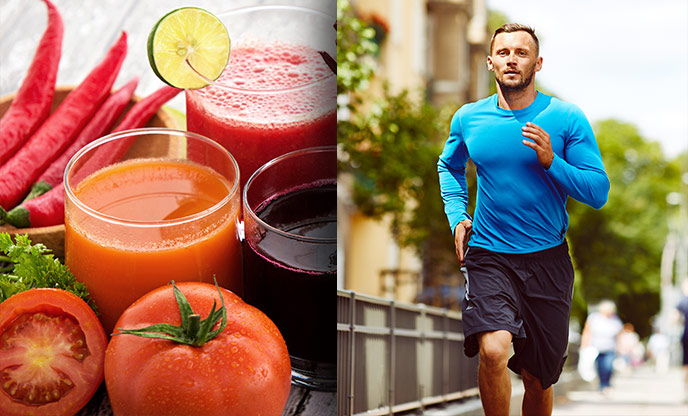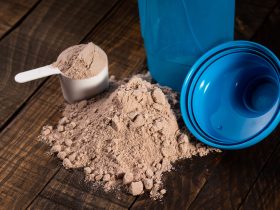
Most runners are taking in lots of calories and nutrients—but it’s in the form of energy bars, nutrient-enhanced drinks, and fortified packaged foods. The problem is, “real” foods—fruits, vegetables, whole grains, lean meats—are better for them than fortified products. Within the body, vitamins, minerals, and other essential nutrients work together with literally thousands of other compounds, such as color components in fruits and vegetables, special starches and fibers in whole grains, and unique fats in seeds, nuts, and dairy. Of course, protein bars and calcium-fortified juices seem like a convenient way to take in all the 50-plus nutrients every runner needs daily. But getting them—and more—from real food is easy. Follow these six rules every day, and your body will get everything it needs for better health and better running.
Rule #1: Eat seeds or foods made from seeds
What makes seeds so special? Seeds—including whole grains, many beans, and even tree nuts—contain the crucial mix of nutrients necessary to grow a new plant, which means they are packed with health-boosting compounds. In addition to traditional nutrients like protein and essential fats, seeds contain bioactive compounds, such as phenolic compounds and ferulic acid, which act as antioxidants. Eating a diet with ample plant seeds has been shown to improve health and help maintain a healthier body weight. People who eat whole grains and beans have a lower risk of developing type 2 diabetes and certain cancers, and they tend to have lower cholesterol levels than people who don’t eat nuts and seeds.
Rule #2: Eat five different colored fruits and vegetables daily
The rich red in pomegranate comes from anthocyanins, the deep red in tomatoes comes from lycopene, and the bright orange in sweet potatoes comes from beta-carotene. These and other pigments have been shown to lower the risk of cancer, heart disease, and Alzheimer’s, while also improving memory. And since most pigments act as antioxidants, they can help reduce inflammation caused by disease or heavy exercise. But new studies suggest that the pigments in produce need to interact with other color compounds in fruits or vegetables to produce their beneficial effects, which is why it’s important to eat a wide variety of colors every day. The results of these studies also explain why taking a single pigment, such as beta-carotene in supplement form, doesn’t lead to the same health improvements as eating whole foods and may even increase the risk for some diseases.
Rule #3: Eat plant foods with their skins intact
Drop the peeler. From apples and black beans to red potatoes and zucchini, plants’ outer skins protect them from UV light, parasites, and other invaders. As a result, those skins are bursting with a wide range of phytochemicals that also protect your health. Grape skins, for example, are high in resveratrol, and onion skins contain quercetin, both of which can help lower your risk of heart disease and colon and prostate cancer and boost your immunity.
Rule #4: Drink milk and eat milk products that come from animals
Dairy supplies a runner’s hardworking muscles with an ample amount of protein to help speed recovery. But whey protein, the specific type of protein found in dairy foods, may also help strengthen the immune system. Milk products also contain stearic acid, which is thought to improve blood cholesterol levels. Ample research also suggests that regular dairy consumption can lower your blood pressure and your risk for heart disease. And for anyone watching his or her weight, studies have shown that dieters who include dairy in their low-calorie plans lose more fat than those who simply cut calories.
Rule #5: Eat foods that come from cold water
Fish and other seafood provide a unique combination of nutrients important to runners. Most seafood is an excellent source of quality protein (you need about 50 percent more protein than your nonrunning friends) and contains zinc, copper, and chromium—minerals that are often low in a runner’s diet. But the omega-3 fats found in fish, particularly those from cold waters, are what make seafood such an essential part of anyone’s diet. People who eat fish and other seafood a few times per week have a lower risk of sudden heart attack, vascular disease, and stroke. Fish intake has also been linked to lower rates of depression. And recently, low intake of fish (and omega-3 fats) has been associated with certain behavioral conditions in children, such as attention deficit hyperactivity disorder.
Rule #6: Eat meat, poultry, or eggs from free-range or grass-fed animals
By eating lean meats, poultry, and eggs, along with dairy products, runners can easily meet their increased protein needs and take in crucial minerals that can be hard to get from non-animal sources. Meats are a great source of iron and zinc, which support healthy red blood cells and a strong immune system. And these two minerals are simply better absorbed by the body when they come from meat instead of nonmeat sources. Sticking to lean meats, however, is key, so consider foods from animals raised in open pastures that graze on grasses. Compared with their stockyard-raised, corn-fed counterparts, free-range, grass-fed animals may contain more omega-3 fats and less artery-clogging saturated fats due to their healthier diets and higher activity levels.
